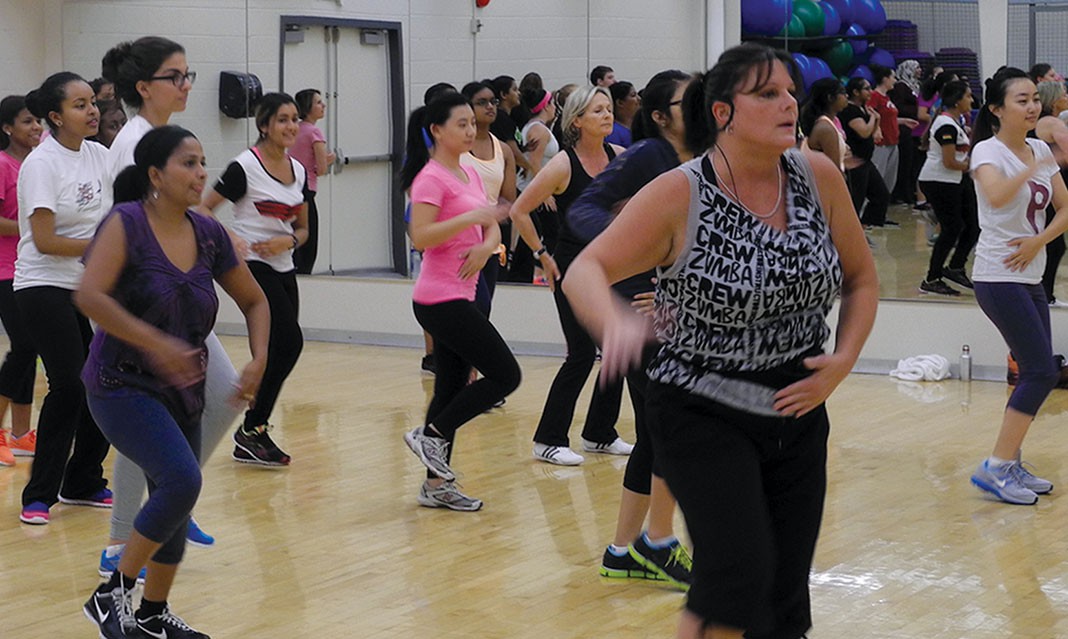“Who’s that sweaty-haired, armpit-stained, make-up-melting mess?” I wondered as I stared into the floor-length mirror reflection of myself. It was at that moment I realised that Zumba was not for the weak. I glanced around the studio, noticing everyone else was hardly breaking a sweat while I was one pelvic thrust away from breaking a hip.
Maybe someone as rhythmically challenged as me should stick to the treadmill, but for more than 30 students who release their inner Shakira every Wednesday night in the RAWC’s dance studio, an hour-long Zumba fitness class offers them a high-energy cardiovascular workout and demands Extra Strength Lady Speedstick.
First-year theatre and drama student George Alevizos describes his first Zumba class as a fun and unique way to engage in alternative exercise. The fact that Alevizos is confined to a wheelchair certainly holds no limitations to the kind of liberation and excitement he feels when he dances during Zumba.
“It doesn’t matter if you have any disability or limitations, you can do whatever you want if you put your mind to it. This is a perfect example of doing something that I love to do, and doing it in my way,” he says. His way at Zumba looked as agile, dexterous, and graceful as other Zumba-goers like Katherine Booth, who has been attending classes for months.
“I love Zumba because it’s easy and fun and it doesn’t feel like a workout,” says Booth, a first-year commerce student.
As an avid disciple of Zumba, she attends multiple classes on and off campus. However, Booth feels that the pop songs selected for today’s Zumba session are different from the more Latin and “Bollywood” style music played in most classes she has attended elsewhere.
“I think UTM has more of an adjusted Zumba, we focus more on the physical component and we dance to mainly pop music, but typical Zumba, in my experience, is more sensual,” she says.
We jokingly discussed the kind of wrist-flicking, hip-swivelling choreography that she had seen take place at her other Zumba classes. But jovialities aside, these dance moves are actually a derivative of some original “Bollywood” or “Latino” ways of dancing. And in overlooking the cultural context from which this music and choreography emerge, could we be committing the moral sin of cultural appropriation in the name of yoga pants and tie-dye shirts?
I pose this question in light of the recent decision to suspend a free yoga class at the University of Ottawa after reports of concerns about “cultural appropriation” were brought forward by the university’s student federation (SFUO).
Cultural appropriation often refers to the power dynamic in which members of a dominant culture adopt elements from a culture that has been systematically oppressed.
Although there have been various reports following the incident about the reasons for the suspension, according to The Ottawa Sun, the SFUO contended that since many of the cultures that yoga practises have been taken from “have experienced oppression, cultural genocide, and diasporas due to colonialism and Western supremacy”, students need to be mindful of the ways in which they express themselves while practising yoga. However, there is much opposition to the decision, and some claim that the labelling of this particular yoga session as cultural appropriation is questionable.
The line between behaviour that encourages empathy and cultivates the genuine interest in culture and behaviour that caricatures or mocks a culture illustrates the distinction between cultural appreciation and appropriation definitively. The opinions of many at UTM’s Zumba class echo my sentiments that this fitness regimen—or, at least, the type practised here at UTM—falls under neither, as the music selected is top 40 and the dance moves are relatively generic. But recently, it has become more important to be able to draw this distinction explicitly and define what actions cross the line from appreciation into appropriation.
Thinking critically of “typical Zumba”, as Booth puts it, I would be remiss if I didn’t point out the underlying cultural appropriation that is apparent in the exaggerated hand movements and unusual hyper-sexualized movements she described. It is hard to discern if these stereotypical Latino, Bollywood, or Middle Eastern “belly dancing” songs end up making a mockery of Indian, Middle Eastern, and Latino cultures through their reliance on stereotypical notions of erotic “otherness”. This may cross the line from appreciation into appropriation. But to make such a conclusion could be considered arbitrary, as there is hardly a formal criterion for what cultural appropriation looks like, at least within the walls of a sweaty dance studio. Clearly, the line between appreciation and appropriation is not a straight one.
Nonetheless, as this war on cultural appropriation perseveres, the attendees of weekly Zumba at UTM will too as they choreographically move in sync, undeniably putting a Beyoncé dance music video to shame. But I’ll take one for the team and sit out for the next class—I don’t think they needed a left shark anyways.




[…] Rhythmic workout or cultural red flag? And in overlooking the cultural context from which this music and choreography emerge, could we be committing the moral sin of cultural appropriation in the name of yoga pants and tie-dye shirts? I pose this question in light of the recent decision to … Read more on The Medium […]